 In the spirit of Black Friday, let's see if we can save some green. Whether you are guilty of joining the Black Friday "festivities" or not, this lesson contains something for you to be aware of in your shopping with coupons.
If you have multiple coupons, of different discount types (amount discount vs. percent discount, that is), then there is a particular way to apply these savings that will earn more savings than the other.Long story short: Apply the percent discount before applying the amount discount for more savings.
The concept relies on the concept of composition of functions, commonly written in the form f(g(x)). These are functions that evaluate in one functions and then another, in a particular order. The topic puts emphasis on evaluating with the order of operations as well as other properties like the commutative property and associative property, both of which are staples in algebraic concepts.
 Remember, always use the percent discount FIRST when given the opportunity. Teaching this lesson in class works well, mainly due to the fact students get so wrapped up in seeing whether they know how to reap the biggest reduction on their purchases in the future. To help solidify their learning, or ward off skeptics on the topic, we try a couple examples: a $50 purchase and a $100 purchase, for ease of computation. Follow along: For a $50 purchase:- $10 discount applied first: $50 - $10 discount = $40, then $40 - (0.2)*$40 = $32 final price
- 20% discount applied first: $50 - (0.2)*$50 = $40, then $40 - $10 = $30 final price
For a $100 purchase:- $10 discount applied first: $100 - $10 discount = $90, then $90 - (0.2)*$90 = $72 final price
- 20% discount applied first: $100 - (0.2)*$100 = $80, then $80 - $70 = $70 final price
It is no strong coincidence that there is a two-dollar difference between these scenarios. This is the critical piece of what I'm trying to convey with this post (oh, and it's a fun math lesson to teach). In using the dollar-discount first, the consumer or retailer is causing the percent-discount to be applied to a smaller value, therefore not letting it stretch as far as it could otherwise. It is, in essence, as if you are also taking the percent OFF of the dollar discount you wish to use (note the examples above, where there is a $2 difference and $2 is 20% of $10). In applying the percent discount first, your percent covers the larger original purchase price and stretches further. This is the gist of why the percent coupon should be applied first, when you have the opportunity. NOTE: Some retailers have a point-of-sale system which is programmed to use the dollar discount first, no matter when you had a coupon to the cashier, so you might be forced to play their game and sacrifice part of your savings. I will not name names, but have had a couple of disappointed students bring in receipts and show me how much MORE they could have saved if the register didn't force the order of discounts applied. I'm making a bunch of links in this sentence if you would like either the TI-Nspire file I have shown up above in the slideshow, or the original presentation and handout I did for this topic to earn T^3 Instructor status a few summers ago. (Don't have a TI-Nspire? Try running the TI-Nspire file through the TI-Nspire Document Player without a need for download of software.)
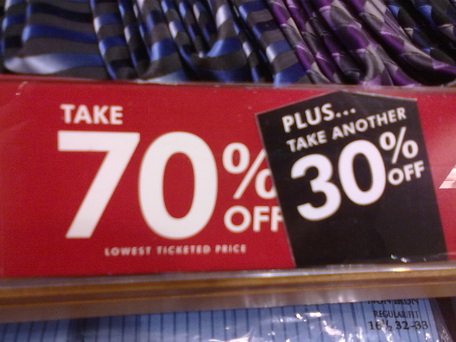 A 101qs.com entry I posted in May, 2012. This was a head-scratcher but good example. I managed to take a trip to an outlet mall, where I saw a curious sale display, pictured at left. To use the word "PLUS" in this instance seemed additionally confusing (yes, pun intended there), and caught the ire of Dan Meyer on his blog shortly after I'd posted the photo to 101qs.com. This, and other sale opportunities like it have been a common cause of commotion in class among my students who have heard me teach this lesson. They are able to bring up new shopping adventures they have had, where they might have corrected the way a cashier had rang something up, or a discount was applied more favorably than they expected, or the discount merely balanced out the sales tax they would have paid anyway. Regardless, the lesson sticks. Applying similar, consecutive discounts have proven to be a decent introduction to exponential growth, since students are aware that "50% off, then another 50% off does not make the item FREE." For those students who are very shopping-savvy, these applications hit home for them much more quickly than any compound interest problem ever could. Speaking of interest, I hope this sparked some of yours. Have a good day and enjoy the holiday season, saving all the while! --Keltner--
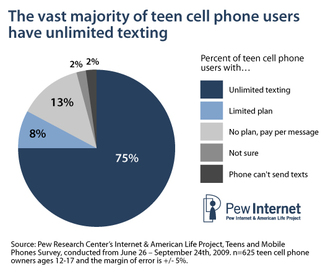 OMG, Unl. TXT FTW!!! I like how this site uses a question posed by a student, akin to "How do I graph a function that has a changing slope?" The example quickly divulges to cell phone pricing structure, a valid place to go The issue I have with their example is that the majority of my students who have cell phones and an awareness of these pricing structures realize quickly how outdated the example is and lose engagement in the class discussion. Cell phones make calls, true; however, the majority of the usage my students' phones see is by text messaging, which most of them have a HUGE allotment of messages per month by their phone plan (many of whom will have unlimited texting anymore). So while the cell phone pricing examples are valid examples to introduce piecewise functions in a context familiar to students, they are quickly outdated by the rapidly changing face of technology today. The Khan Academy example I found that lends itself to piecewise functions takes almost 3 minutes to get the example drawn on the screen (while Sal says twice "I hope I'm not boring you while I'm drawing this" and also "I really should have something that lets me just get the graph image in place quickly"). I have to be a bit lenient, though, because his video was posted in 2007 which is better than I was doing back then (I was, however, using a SMART Board regularly in daily class activity though and feigned a couple efforts at uploading my stuff). Students become quickly detached from examples in their textbook and I would have a hard time justifying asking them to watch a 9-minute KA video where the first 3 minutes are setting up the example.
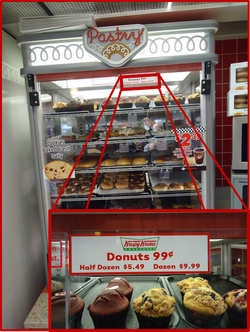 I visited the convenience store in town and compiled this photo (the one pictured above left) of their donut case, which indeed exhibits the characteristics for a piecewise function (while also allowing us to discuss the greatest integer function, since we can only purchase whole number quantities of donuts). I simply project the image in class when they come in and have already set the scene for the lesson, despite having to address the "So, we're taking a field trip today?" and "Did you bring snacks?" comments from students as they arrive. [NOTE: The amount of time showing this image in class should be inversely proportional to the amount of time to the nearest meal for your students.] Have students create a price table for the quantity of donuts purchased, from 0 to about 15. They get an interesting surprise around the dozen-donut mark (namely that 11 donuts costs $10.44 and 12 donuts costs $9.99--so it is as if the 12th donut earns you a $0.45 refund!). These sort of conclusions are ones students treat as an inside joke among their other classmates, so don't sell it short despite the nerdiness it entails. Since we're supposed to help our students make real-world connections, this is a prime example--and a delicious one, to boot.
 Krispy Kreme price chart. Have students construct it and see if they notice anything around the dozen-donut mark. In the video examples I complete below using foldables, I try to emphasize that each of the PIECES of the function could stand alone by themselves with no restriction on their domain(s). With a piecewise-defined function, we are merely piecing together the parts of the individual functions that are requested in the piecewise function that DOES specify constraints on the individual component functions.
 This is the example worked out in the YouTube video below. A copy of the foldable used for a 2-piece piecewise function can be found HERE.
 This is the example worked out in the YouTube video below. A copy of the foldable used for a 3-piece piecewise function can be found HERE.
Obviously, I need to develop a better way to make a quick demo of lessons like this. These were each done on my iPad2, so I'm pretty pleased with the capability of them to collect decent sound and video. What I did not show were the cue cards I created for myself just behind the iPad so I could more quickly graph and plot the functions (something Sal did not do on his example I mentioned earlier). Oh, and I included a shout out to Vi Hart for having used Sharpies for both of the videos. So, I've got that going for me, which is nice. Piece, I'm outta here. Yes, I misspelled that. I meant to. Math puns are hard, I gotta take what I can get. --Keltner--
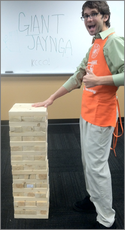 As the summer wound down, I found myself frequenting home improvement stores to cross of those last few items on my to-do list. In that wandering, I came across a Giant Jenga topic on a Home Depot Community blog by employees/associates. I figured this would be a great way to tie-in at the beginning of the school year to talk about traits of shapes (in this case squares, so that the Jenga tower has no overlapping from one level to the next). Particularly, I wanted them to address the trait of the assembly that the length of each board was supposed to be the width multiplied by the number of boards stacked across the assembly--in this case, 3 x 5.5" since we went three boards across and each measured 5.5" wide. I was able to toss the idea at the woodworking teacher, who was going to be biding his time in class until students had passed their safety quizzes so they could safely operate the machinery in their shop. He agreed that a straightforward, repetitive project like this one would allow his students to use multiple machines (miter saw, table saw, and planer for example). Before embarking on the project, I made sure to set the scene with my students and pique their interest in creating their own Giant Jenga. They insisted we Google it to see if someone else had already come up with the idea before them. A sweet collection of games came up, but mostly photos, aside from the Home Depot article I'd mentioned above. They noticed it included measurements (i.e. the answer, they thought). I agree with Dan Meyer here: questions like these are most effective when they are un-Google-able.
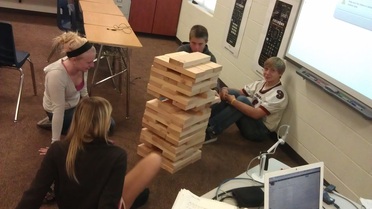 Students try out our Giant Genga game as a reward for their efforts. I insisted we go bigger than the Home Depot site had done; we should use 2" x 6" boards instead. The task in class that day was for them to help me make out my shopping list. Some prompts we had to answer: - Why did the Home Depot site mention each board being cut to 10.5" long?
- Would that same length apply when using 2" x 6" boards?
- Could we just buy the longest boards available, or would 8-foot, 10-foot, or 12-foot boards help minimize waste?
- How many, and which length, should I purchase? (When I was at the store, I also discovered the unit rate for these boards differed somewhat; namely that the shorter boards were the cheapest for foot-length. I anticipate revisiting this observation in a later lesson.)
The final product is pictured here. Although it is heavy and not "broken in yet" where the pieces slide easily in and out of their slots, students have enjoyed playing it in the couple of opportunities they have had. The other students from the woodworking class have come by to see the final product in action, since they only saw the raw materials and had not seen the final product in action. I saw recently where Andrew Stadel had posted about an "experienced" Rubik's cube he held onto and a curious student managed to master quickly. While I have a growing collection of Rubik's cubes and similar puzzles (as seen on the banner for this site, atop the shelves in my classroom with Hoberman spheres and other math-y relics), I hope this Giant Jenga game at least makes an impact on these students since they are the ones who came up with the recipe--or the shopping list, I suppose. --Keltner--
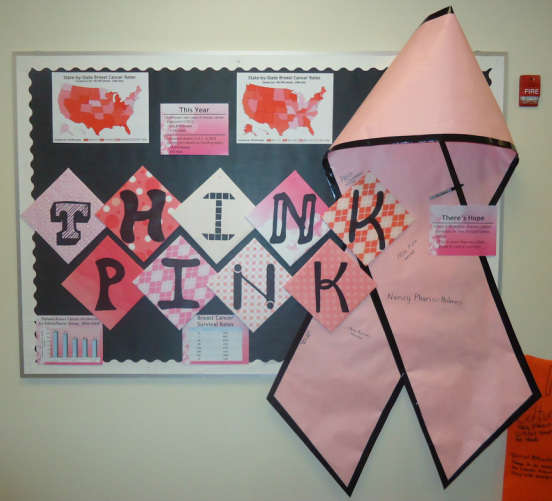
This bulletin board is posted outside my classroom to recognize Breast Cancer Awareness Month in October.
Breast cancer affects more people than we easily realize. I learned that this week. As I started to piece this bulletin board display together, a number of passersby made casual comments to the effect of "That's really cool, Mr. Keltner. My ______ (friend, aunt, grandma, father, brother's roommate, and many other examples) is a cancer survivor." If comments like that don't make you glow inside and out, I don't know what to tell you.
After a colleague shared that his mother is a cancer survivor, I'd heard enough. I couldn't just keep all these blessings to myself. I had to share this list of loved ones with others. So, as you can see above, I've begun to accumulate the names of cancer survivors on the four-foot tall pink ribbon adorning the bulletin board.  Nancy and the late Larry Holmes, 2006. I'd like to share a bit about the woman whose name I made sure to include FIRST and foremost on that big ribbon. Her name is Nancy Holmes and I came to know her through a summer job I held with a Full Bright Sign & Lighting, a job that has given me numerous opportunities for real-life math examples in class. It didn't take long to learn that this woman was a fighter, not just advocating to get things done properly and efficiently in the workplace, but that she was a breast cancer survivor. Both breasts. Treated and diagnosed at separate times. Also through this summer job, I came to know Larry. To say he was a gentleman is an understatement. He, too, was a cancer survivor and married Nancy in 2006 after having met during their treatment while each battling cancer. So, when I hear celebrities talk about a "power couple," I know they could not even hold a candle to Nancy and Larry.
 Homecoming King Owen Phariss and his TWO Queens, Audrey Hughes (left) and Rachel Heeb (right). What's more, Nancy's son Owen is her pride and joy. A success story for what someone can do with Down's syndrome (and his mother's strength and determination), Owen was named Homecoming King at his high school during his senior year, a noteworthy occasion not just for him but also for his QUEENS. That's right, the queen voting resulted in an exact tie, so two girls were crowned.So, all the amount of time spent on this bulletin board pale in comparison to the energy Nancy has spent through her fights with cancer. Yes, fights. And while I feel like this bulletin board definitely is something that is Pinterest-worthy, I hope that students, staff, and other passersby are able to soak in the awareness that it is intended for. I hope they are willing to honor a loved one and post their name to acknowledge the fight they have endured. In the meantime, if you have someone whose name you would like me to post on this display among other cancer survivors, send me a comment, a tweet, or an email. Until next time, THINK PINK. --Keltner--
|













 RSS Feed
RSS Feed